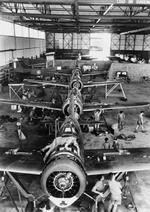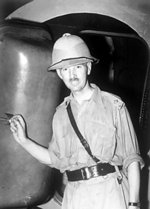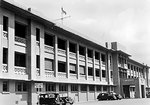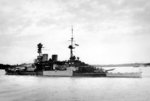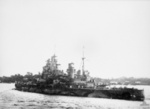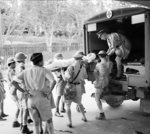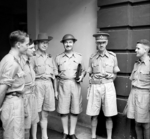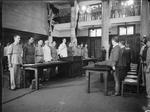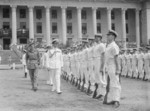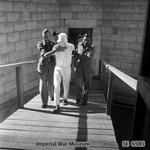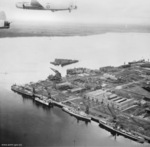12 Aug 1939
Singapore
Singapore
15 Mar 1940
Singapore
Singapore
9 May 1940
Singapore
Singapore
20 Dec 1941
Singapore
Singapore
- British military personnel at the 101st Special Training School in Singapore began training members of the Malayan Communist Party in guerrilla warfare tactics. ww2dbase [Invasion of Malaya and Singapore | Singapore | CPC]
31 Dec 1941
Singapore
Singapore
- In Singapore, British and Dutch transports took on civilians for evacuation to South Africa. ww2dbase [Invasion of Malaya and Singapore | Singapore | CPC]
1 Feb 1942
Singapore

Singapore
- Japanese troops reached Singapore, pausing for the following few days to prepare for a landing on the island. Meanwhile, General Arthur Percival announced that "the battle of Malaya has come to an end and the battle of Singapore has started.... Today we stand beleaguered in our island fortress. Our task is to hold this fortress until help can come." ww2dbase [Invasion of Malaya and Singapore | Singapore | CPC]
- Japanese troops reached Singapore, pausing for the following few days to prepare for a landing on the island. Meanwhile, General Arthur Percival announced that "the battle of Malaya has come to an end and the battle of Singapore has started.... Today we stand beleaguered in our island fortress. Our task is to hold this fortress until help can come." ww2dbase [Invasion of Malaya and Singapore | Singapore | CPC]

2 Feb 1942
Singapore
Singapore
- Japanese aircraft attacked naval facilities at Singapore, forcing Allied warships to withdraw for the Dutch East Indies. ww2dbase [Invasion of Malaya and Singapore | Singapore | CPC]
5 Feb 1942
Singapore
Singapore
- Japanese troops attacked the Pulau Ubin island to the northeast of Singapore, drawing British troops to move to that region; the actual attack would come from the northwest three days later. Out at sea, passenger liner Empress of Asia, with reinforcement for Singapore aboard and fallen behind from fellow BM12 convoy members, was attacked and sunk by 9 Japanese aircraft; although the loss of life was small (16 killed), all the weapons and equipment aboard her were lost; 1,804 survivors were rescued by Australian sloop HMAS Yarra. ww2dbase [Invasion of Malaya and Singapore | Singapore | CPC]
- Japanese troops attacked the Pulau Ubin island to the northeast of Singapore, drawing British troops to move to that region; the actual attack would come from the northwest three days later. Out at sea, passenger liner Empress of Asia, with reinforcement for Singapore aboard and fallen behind from fellow BM12 convoy members, was attacked and sunk by 9 Japanese aircraft; although the loss of life was small (16 killed), all the weapons and equipment aboard her were lost; 1,804 survivors were rescued by Australian sloop HMAS Yarra. ww2dbase [Invasion of Malaya and Singapore | Singapore | CPC]
6 Feb 1942
Singapore
Singapore
- Japanese artillery and aerial bombardment continued against various military and port facilities at Singapore. ww2dbase [Invasion of Malaya and Singapore | Singapore | CPC]
9 Feb 1942
Singapore
Singapore
- During the day, Japanese troops captured Tengah airfield at Singapore while behind the front 10,000 additional troops arrived at the beachheads. At 2100 hours, the Japanese 4th Imperial Guard Regiment landed at Kranji in northern Singapore, but the attempt was driven off by Australian 27th Brigade's heavy machine gun and mortar fire before the Australians fell back in anticipation of another landing. ww2dbase [Invasion of Malaya and Singapore | Singapore | CPC]
- During the day, Japanese troops captured Tengah airfield at Singapore while behind the front 10,000 additional troops arrived at the beachheads. At 2100 hours, the Japanese 4th Imperial Guard Regiment landed at Kranji in northern Singapore, but the attempt was driven off by Australian 27th Brigade's heavy machine gun and mortar fire before the Australians fell back in anticipation of another landing. ww2dbase [Invasion of Malaya and Singapore | Singapore | CPC]
10 Feb 1942
Singapore
Singapore
- Australian 22nd Brigade misunderstood an order and withdrew past the Jurong Road in northern Singapore, thus exposing the flanks of neighboring Indian troops, forcing the entire Allied line to shift further south. Meanwhile, the British Royal Air Force withdrew the small number of aircraft from Singapore to prevent Japanese capture. After sundown, Japanese troops captured the Bukit Timah heights which overlooked Singapore and hosted two reservoirs of fresh water. ww2dbase [Invasion of Malaya and Singapore | Singapore | AC, CPC]
11 Feb 1942
Singapore
Singapore
- Battle of Bukit Timah: Japanese 5th Division attacked British, Commonwealth, and Chinese (Dalforce irregulars) troops along the Choa Chu Kang Road at Bukit Timah Hill in Singapore. Supported by 50 tanks, Japanese troops halted the Allied counterattacks and took the hill. After the battle, to avenge their casualties, the Japanese troops massacred Chinese civilians living in a nearby village. ww2dbase [Invasion of Malaya and Singapore | Singapore | CPC]
12 Feb 1942
Singapore
Singapore
- Before dawn, British cruiser HMS Durban, destroyer HMS Stronghold, destroyer HMS Jupiter, transport Empire Star, and transport Gorgon departed Singapore with British Royal Navy personnel for Batavia, Java, Dutch East Indies; they would be attacked and damaged by Japanese aircraft en route. Meanwhile, on Singapore island, Japanese troops made conservative probing attacks in western Singapore as the Allies slowly withdrew into the city. ww2dbase [Invasion of Malaya and Singapore | Singapore | CPC]
13 Feb 1942
Singapore
Singapore
- Japanese troops pushed the 55th Brigade of the British 18th Division out of its position which controlled the last fresh water reservoir in Singapore for the British. Arthur Percival's senior staff members persuaded him to request permission to surrender. At 1830 hours, a large convoy of 44 ships departed Singapore with evacuees; a few of these ships would be attacked and sunk by Japanese aircraft. ww2dbase [Invasion of Malaya and Singapore | Singapore | CPC]
14 Feb 1942
Singapore
Singapore
- Despite being wounded, Adnan bin Saidi continued to retire from his forward position in Singapore. When his position was finally taken by Japanese troops, he was tied to a tree and bayoneted to death. ww2dbase [Adnan bin Saidi | Singapore | CPC]
- While Japanese troops penetrated the lines manned by the 1st Malay Brigade at Singapore and reached the Alexandra Barracks Hospital, where 323 hospital staff and patients would soon be brutally massacred, Archibald Wavell rejected Arthur Percival's request to surrender Singapore. ww2dbase [Invasion of Malaya and Singapore | Singapore | CPC]
15 Feb 1942
Singapore
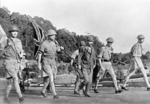


Singapore
- With Winston Churchill's permission, Arthur Percival decided to surrender Singapore. A delegation bearing a white flag was dispatched at 1130 hours, but it was turned back by the Japanese, who requested Percival to surrender in person, which Percival complied at 1715 hours. At the Ford Motor Factory at Bukit Timah, Percival signed the surrender document at 2030 hours, making the biggest capitulation in British militay history official. ww2dbase [Invasion of Malaya and Singapore | Singapore | AC, CPC]



16 Feb 1942
Singapore


Singapore
- The Sook Ching massacre began in Singapore during which somewhere between 5,000 (Japanese estimates) and 100,000 (Singaporean estimates) ethnic Chinese civilians were killed during the following 3 weeks. ww2dbase [Invasion of Malaya and Singapore | Singapore | CPC]


17 Feb 1942
Singapore
Singapore
- Japanese occupation administration at Singapore sent 3,000 British civilians to Changi prison and 50,000 British, Australian, and Indian captured troops to Selarang Barracks. Some of the captured Indian troops were taken to hear Captain Mohan Singh at Farrer Park, who attempted to persuade them to collaborate with the Japanese. ww2dbase [Changi Prison and Selarang Barracks | Invasion of Malaya and Singapore | Singapore | CPC]
10 Apr 1942
Singapore
Singapore
28 Apr 1942
Singapore
Singapore
29 Apr 1942
Singapore
Singapore
6 May 1942
Singapore
Singapore
2 Jun 1942
Singapore
Singapore
30 Aug 1942
Singapore
Singapore
- Over 20,000 British and Australian prisoners of war at the Selarang prisoner of war camp in Singapore refused to sign a pledge promising they would not attempt to escape. The Japanese rounded up these uncooperative prisoners of war, placed them in the central plaza, and denied them food, water, and medical treatment. Four prisoners who had previously attempted to escape were executed in front of the group to set an example. ww2dbase [Changi Prison and Selarang Barracks | Singapore | CPC]
4 Sep 1942
Singapore

Singapore
- After seeing several comrades die from dysentery without medical attention, the commanding officer of the protesting prisoners of war at Selarang prisoner of war camp in Singapore gave the order to abandon the protest against the Japanese demand that they pledge to not make any attempts to escape their imprisonment. ww2dbase [Changi Prison and Selarang Barracks | Singapore | CPC]

29 Dec 1942
Singapore
Singapore
- Raizo Tanaka was transferred to Singapore to recuperate from combat wounds suffered on 12 Dec 1942. ww2dbase [Raizo Tanaka | Singapore | CPC]
20 Feb 1944
Singapore
Singapore
1 Mar 1944
Singapore
Singapore
4 Apr 1944
Singapore
Singapore
14 Feb 1945
Singapore
Singapore
- Japanese hospital ship Hikawa Maru departed Singapore. ww2dbase [Hikawa Maru | Singapore | CPC]
4 Jun 1945
Singapore
Singapore
- Japanese hospital ship Hikawa Maru arrived at Seletar, Singapore. ww2dbase [Hikawa Maru | Singapore | CPC]
5 Jun 1945
Singapore
Singapore
- Japanese hospital ship Hikawa Maru departed Seletar, Singapore. ww2dbase [Hikawa Maru | Singapore | CPC]
18 Aug 1945
Singapore
Singapore
- At the headquarters of the Japanese 7th Area Army in Singapore, General Seishiro Itagaki informed his lieutenants and colonial administrators that Japan had surrendered. He ordered the men to maintain public order and to plan for the transition of power when the British colonial administration would arrive. He also ordered the construction of an internment camp in Jurong in western Singapore for Japanese civilians, who would wait there until repatriation. ww2dbase [Seishiro Itagaki | Japan's Surrender | Singapore | CPC]
20 Aug 1945
Singapore
Singapore
- The Singapore-based Japanese newspaper Syonan Shimbun announced the surrender and reproduced the transcript of the Imperial Rescript. ww2dbase [Singapore | CPC]
30 Aug 1945
Singapore
Singapore
- The first of the 6,000 Japanese civilians in Singapore began to move into the newly completed Jurong Interment Camp. ww2dbase [Japan's Surrender | Singapore | CPC]
3 Sep 1945
Singapore
Singapore
5 Sep 1945
Singapore
Singapore
- British and Indian troops entered Singapore where they liberated 33,000 prisoners of war. Japanese civilian administration leaders gathered at the City Hall to present them the extensive briefings they had prepared in the last two weeks to assist in a smooth transition of power, but the British refused to acknowledge them. ww2dbase [Singapore | AC, CPC]
6 Sep 1945
Singapore
Singapore
- The newly returned British colonial administration of Singapore demolished the memorial for Subhas Chandra Bose, an Indian nationalist leader who collaborated with the Japanese during the war. Elsewhere, the Japanese civilian administration leaders were marched, on foot, to the Jurong internment camp in the western side of the island. ww2dbase [Singapore | CPC]
21 Oct 1945
Singapore
Singapore
- 7,000 workers at the harbor in Tanjong Pagar, Singapore staged a strike, demanding higher wages and protesting against the shipment of weapons from Singapore to Indonesia to be used against nationalist forces. ww2dbase [Singapore | CPC]
13 Jan 1946
Singapore
Singapore
- A funeral service for Lim Bo Seng was held at the City Hall of Singapore. ww2dbase [Lim Bo Seng | Singapore | CPC]
17 Oct 1947
Singapore
Singapore
- SB No. 125 (formerly landing ship No. 108) and another SB ship (formerly landing ship No. 110) were surrendered to the United Kingdom at Singapore. ww2dbase [No. 101/103-class | Singapore | CPC]
Please consider supporting us on Patreon. Even $1 per month will go a long way! Thank you. Please help us spread the word: Stay updated with WW2DB: |
Search WW2DB

News
- » Wreck of Teruzuki Found (27 Jul 2025)
- » USS Orlean's Bow Found (22 Jul 2025)
- » The Emperor of Japan Planned to Honor WW2-era Japanese POWs in Mongolia (4 Jul 2025)
- » US State Lawmaker John Winter Caught Using Racial Slur "Jap" and Apologized (11 Jun 2025)
- » US Government Plans to Purge WW2 Information (17 Mar 2025)
- » See all news
Random Photograph
Billboard celebrating USS Wahoo at Mare Island Navy Yard, Vallejo, California, United States, mid-1943Current Site Statistics
- » 1,181 biographies
- » 337 events
- » 45,111 timeline entries
- » 1,247 ships
- » 350 aircraft models
- » 207 vehicle models
- » 376 weapon models
- » 123 historical documents
- » 261 facilities
- » 470 book reviews
- » 28,476 photos
- » 365 maps
Famous WW2 Quote
"The raising of that flag on Suribachi means a Marine Corps for the next 500 years."James Forrestal, Secretary of the Navy, 23 Feb 1945
Support Us
Please consider supporting us on Patreon. Even $1 a month will go a long way. Thank you!
Or, please support us by purchasing some WW2DB merchandise at TeeSpring, Thank you!
